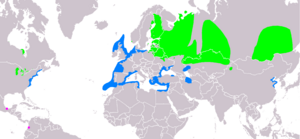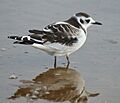Little gull facts for kids
Quick facts for kids Little gull |
|
|---|---|
 |
|
| Conservation status | |
| Scientific classification | |
| Genus: |
Hydrocoloeus
|
| Species: |
minutus
|
 |
|
| Range of H. minutus Breeding Non-breeding Vagrant (seasonality uncertain) | |
| Synonyms | |
|
|
The little gull (Hydrocoloeus minutus) is the smallest type of gull in the world! These birds live mainly in Europe and Asia, but some can also be found in North America. They like to breed near fresh water and spend their winters out at sea. It's the only species in its group, called Hydrocoloeus.
Contents
How Scientists Name Animals: Taxonomy
The little gull was first officially described in 1776 by a German bird expert named Peter Simon Pallas. He called it Larus minutus. Its first known home was in Siberia.
Later, in 1829, another scientist named Johann Jakob Kaup suggested a new group, or genus, for this bird: Hydrocoloeus. So, the full scientific name for the little gull became Hydrocoloeus minutus. This name is now accepted by scientists. The little gull belongs to the gull and tern family, called Laridae. This family is part of a larger group of birds known as Charadriiformes.
What's in a Name? Etymology
The name Hydrocoloeus comes from ancient Greek words. "Hydro" means "water," and "koloios" means a type of web-footed bird.
The second part of its name, minutus, comes from Latin. It simply means "small." So, its name basically means "small water bird."
What the Little Gull Looks Like: Description
The little gull is truly tiny! It's about 24 to 28 centimeters (9.4 to 11 inches) long. Its wingspan is about 62 to 69 centimeters (24 to 27 inches). This makes it the smallest gull species on Earth.
When they are ready to breed, adult little gulls have a black head, a dark red beak, and bright red legs. Their underside can even have a pinkish glow!
When they are not breeding, adults have a black cap and a small black spot near their ear. Their underside is white, their beak is black, and their red legs are not as bright. All adult little gulls have a light gray back and upper wings. Their white flight feathers stand out against very dark gray underwings.
Young little gulls have large blackish areas on their back and head. When they fly, you can see a dark "W" shape on their upper wings. Their underwings are white. By their first winter, their head and body look more like an adult's. But they still have the special upperwing pattern. By their second year, they look very much like adults, but they might still have some black feathers.
Where Little Gulls Live: Distribution
Little gulls live across a wide area, mostly in Europe and Asia. They breed from northern Scandinavia and the eastern Baltic Sea all the way to eastern Siberia. You can also find them breeding in North America, especially around the Great Lakes.
These birds migrate, meaning they travel long distances. They spend their winters along the coasts of Europe, as far south as the Mediterranean, Black, and Caspian Seas. They are not very common in the western Pacific. In North America, they winter along the Atlantic coasts in small numbers. Some go as far south as the Carolinas.
Recently, more non-breeding little gulls have been spending their summers in western Europe. In 2016, they even nested successfully for the first time in Great Britain. This happened at a special bird reserve in Scotland.
Where Little Gulls Like to Live: Habitat
Little gulls build their nests in places with lots of plants. They prefer shallow freshwater areas, slow rivers, marshes, and bogs. They like plants that stick out of the water or have floating leaves. Sometimes, they might use coastal lagoons or slightly salty water.
When they are migrating, these birds usually stay near the coast. But sometimes you can find them inland. In winter, they live on the coast where there is sand and mud. They also like river mouths and even open sea. They might even visit places where sewage is released.
Little Gull Life: Biology
Little gulls are migratory birds. This means they have different places for breeding and for spending the winter. They usually arrive at their breeding areas from late April to late May. They start leaving these areas in mid-July.
They begin laying eggs in mid-June. Little gulls often nest with other types of gulls and terns, forming mixed colonies. However, some pairs might nest by themselves away from these groups.
When they are not breeding, little gulls are very social. They feed and rest in large groups. These groups can be huge, sometimes thousands of birds! This happens if bad weather forces them into calm waters.
Their nests are on the ground or floating on water, attached to plants. In colonies, nests are usually about 1 to 1.5 meters (3 to 5 feet) apart.
When breeding, little gulls eat insects. They catch these insects while flying close to the water. In winter, their diet changes. They mostly eat small fish and tiny sea creatures.
Gallery







